
A lot of shorter aviation gags are featured today, with only one film chiefly devoted to the subject, as we wing our way through the mid-1950’s. Pretty much all the remaining active cartoon studios except Disney get to jump on the runway.
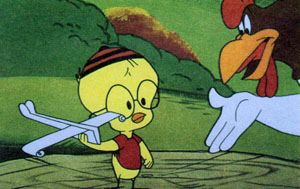 We begin with an omission from past chronology. Little Boy Boo (Warner, Foghorn Leghorn, 6/5/54 – Robert McKimson, dir.), introduces Foghorn to brain boy Egghead Jr., who he attempts to befriend to impress Miss Prissy as prospective father material so that he can occupy Prissy’s comfortable roost during the cold winter. The film features a memorable lesson in aeronautics, as Foghorn tries to teach the tyke how to make a paper airplane. Foggy folds the usual triangle-based design familiar to all who have tried the trick, and launches it into the sky. Egghead selects a second piece of paper, but folds it into a revolutionary design with defined fuselage and tail surfaces, and thin aerodynamic wings with “drop tank” curls on the wing tips. “No no, boy”, blusters Foghorn, claiming that Egghead has it all wrong, and that his plane will never – – Fly? Foghorn’s dialogue ramble is interrupted by Egghead’s plane passing him with the sound of a jet engine and a flaming contrail of exhaust from its rear. The new-fangled creation gains altitude, turns, and closes in on the tail of Foghorn’s plane, suddenly producing a hail of miniature machine-gun bullets from its nose, to shoot Foggy’s craft down in flames. Egghead’s plane comes in for a perfect three-point landing at Foghorn’s feet, and Foggy has to pick it up to watch it unfold back into a sheet of paper before he can quite believe what he has witnessed. Noting Foghorn’s confusion, Egghead scribbles a set of equations on a third sheet of paper to demonstrate to Foghorn how he did it. Foghorn does not even wait for the paper. “Oh, never mind, Einstein. Knowing the answer wouldn’t do me no good anyway.”
We begin with an omission from past chronology. Little Boy Boo (Warner, Foghorn Leghorn, 6/5/54 – Robert McKimson, dir.), introduces Foghorn to brain boy Egghead Jr., who he attempts to befriend to impress Miss Prissy as prospective father material so that he can occupy Prissy’s comfortable roost during the cold winter. The film features a memorable lesson in aeronautics, as Foghorn tries to teach the tyke how to make a paper airplane. Foggy folds the usual triangle-based design familiar to all who have tried the trick, and launches it into the sky. Egghead selects a second piece of paper, but folds it into a revolutionary design with defined fuselage and tail surfaces, and thin aerodynamic wings with “drop tank” curls on the wing tips. “No no, boy”, blusters Foghorn, claiming that Egghead has it all wrong, and that his plane will never – – Fly? Foghorn’s dialogue ramble is interrupted by Egghead’s plane passing him with the sound of a jet engine and a flaming contrail of exhaust from its rear. The new-fangled creation gains altitude, turns, and closes in on the tail of Foghorn’s plane, suddenly producing a hail of miniature machine-gun bullets from its nose, to shoot Foggy’s craft down in flames. Egghead’s plane comes in for a perfect three-point landing at Foghorn’s feet, and Foggy has to pick it up to watch it unfold back into a sheet of paper before he can quite believe what he has witnessed. Noting Foghorn’s confusion, Egghead scribbles a set of equations on a third sheet of paper to demonstrate to Foghorn how he did it. Foghorn does not even wait for the paper. “Oh, never mind, Einstein. Knowing the answer wouldn’t do me no good anyway.”
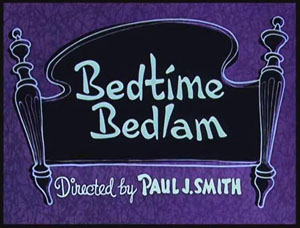 Bedtime Bedlam (Lantz/Universal, Woody Woodpecker, 7/4/55, Paul J. Smith, dir.) doesn’t fare as well for Smith as last week’s “Private Eye Pooch” – not necessarily from any flaw in directing, but from a Homer Brightman script that falls short for lack of a plausible ending. Baby sitter Woody, star sitter of the Sitting Pretty baby service (founded by Sitting Bull), is intrigued by a call offering the whopping fee of $50.00 for a babysitting assignment, at the home of Mr. and Mrs. J.P. Moneybelt. Woody appears at their door almost before the phone has hung up, and starts things off on the wrong foot, by placing a bottle in the mouth of the diminutive Mr. Moneybelt. The real baby rests in a cradle, unseen as yet by Woody. Considering himself an old pro at this racket, Woody ushers the parents out of the house before they can even advise on the baby’s needs, then piles up the sandwiches and cokes around the easy chair and finds the TV remote, to spend a relaxing and lucrative evening. But the baby’s cry signals him that a little effort will be necessary after all. He brings a bottle over to the cradle, and reaches under the blankets to play “Kitchy Kitchy” with the baby’s toes. A huge furry brown foot emerges, and takes hold of Woody like a hand, lifting him into the cradle. Its owner turns out to be – a gorilla! Woody finds the explanation for this turn of events on the wall, spotting a photograph of the Moneybelts dressed as African explorers, with the gorilla in diapers between them, with inscription, “Out baby”. “Not me”, states Woody, and races for the door – until a thought stops him dead in his tracks – the 50 bucks! In one of the best reaction takes in the film, Woody’s face screws up into tightened extremes, closely resembling the ponderings of Bugs Bunny in “8 Ball Bunny” as he exclaims, “Oohh, I’m dyin’ again!” Greed thus keeps Woody on duty. Burping baby gets complicated when Baby downs bubble gum during the process, producing a mammoth inflation and pop. Changing diapers requires bedsheets the width of the room, which when finally wrapped around baby, also include Woody knotted up in the rear. Baby’s refusal to go to sleep results in several activities designed to tire him out, one of which involves a game of cowboys and Indians, Woody playing the brave.
Bedtime Bedlam (Lantz/Universal, Woody Woodpecker, 7/4/55, Paul J. Smith, dir.) doesn’t fare as well for Smith as last week’s “Private Eye Pooch” – not necessarily from any flaw in directing, but from a Homer Brightman script that falls short for lack of a plausible ending. Baby sitter Woody, star sitter of the Sitting Pretty baby service (founded by Sitting Bull), is intrigued by a call offering the whopping fee of $50.00 for a babysitting assignment, at the home of Mr. and Mrs. J.P. Moneybelt. Woody appears at their door almost before the phone has hung up, and starts things off on the wrong foot, by placing a bottle in the mouth of the diminutive Mr. Moneybelt. The real baby rests in a cradle, unseen as yet by Woody. Considering himself an old pro at this racket, Woody ushers the parents out of the house before they can even advise on the baby’s needs, then piles up the sandwiches and cokes around the easy chair and finds the TV remote, to spend a relaxing and lucrative evening. But the baby’s cry signals him that a little effort will be necessary after all. He brings a bottle over to the cradle, and reaches under the blankets to play “Kitchy Kitchy” with the baby’s toes. A huge furry brown foot emerges, and takes hold of Woody like a hand, lifting him into the cradle. Its owner turns out to be – a gorilla! Woody finds the explanation for this turn of events on the wall, spotting a photograph of the Moneybelts dressed as African explorers, with the gorilla in diapers between them, with inscription, “Out baby”. “Not me”, states Woody, and races for the door – until a thought stops him dead in his tracks – the 50 bucks! In one of the best reaction takes in the film, Woody’s face screws up into tightened extremes, closely resembling the ponderings of Bugs Bunny in “8 Ball Bunny” as he exclaims, “Oohh, I’m dyin’ again!” Greed thus keeps Woody on duty. Burping baby gets complicated when Baby downs bubble gum during the process, producing a mammoth inflation and pop. Changing diapers requires bedsheets the width of the room, which when finally wrapped around baby, also include Woody knotted up in the rear. Baby’s refusal to go to sleep results in several activities designed to tire him out, one of which involves a game of cowboys and Indians, Woody playing the brave.
 The baby plays cowboy his own way, by grabbing his parents’ elephant gun off the wall and shooting Woody point blank on the beak, reducing the tip of his bill to a burnt-out matchstick. “Is this worth the 50 bucks?”, ponders Woody – then answering himself, “Yeah!” After several more violent efforts to knock the baby out, including two leaps off the building penthouse, Woody follows the final instruction in his baby-sitting manual: “If all else fails, ROCK baby to sleep.” This is accomplished by tying a huge boulder to a rope and pulley in the ceiling, then cutting the rope to let the boulder fall on the ape. Unphased by any pain, the gorilla quietly yawns, then falls to sleep on the spot. Woody finally settles down in the easy chair, and returns to his TV show. Now comes the bad news – and the weak ending. A news flash from the airport shows us Mr. and Mrs. Moneybelt, boarding a flight, bound for a 20-year trek into darkest Africa. “My fifty bucks!” shouts Woody, knowing he’s been double-crossed. (Now Mr. Brightman, lets think this thing through. You had the Moneybelt’s already state they needed Woody for “the evening” in the opening call – so what’s with this twenty years? Did they really expect Woody to be gullible enough to wait that long? And if the gorilla is their “baby”, how can they be so cruel as to run out on him for 20 years? Did they expect Woody to adopt him?) It’s all pretty silly, but Woody puts a stop to their plans quickly, by grabbing the elephant gun, and blasting a shot at the TV screen. The glass tube remains unshattered, but somehow the plane on screen is full of holes, and is brought down for a crash. As a parting gesture, Woody takes a large pan, and drums loudly upon it atop the sleeping gorilla’s head to wake him and get him crying, then takes his exit of the abode with his signature laugh. Smith gets plenty of giggles and delivers fast timing – but no director could have rescued the plot hole left for an ending to close out this uneven episode. It would take Michael Maltese to come up with a better solution in Snooper and Blabber’s “Big Diaper Caper”, where their quest for a whopping baby-sitting fee is defeated by being scared out of their wits by the Frankenstein-like baby of Mr. and Mrs. J. Evil Scientist. Mrs. Scientist bemoans that their hp another pair of baby sitters lost to their service. “But consider, my dear”, observes Mr. Scientist, “we’ve never had to pay for one yet.”
The baby plays cowboy his own way, by grabbing his parents’ elephant gun off the wall and shooting Woody point blank on the beak, reducing the tip of his bill to a burnt-out matchstick. “Is this worth the 50 bucks?”, ponders Woody – then answering himself, “Yeah!” After several more violent efforts to knock the baby out, including two leaps off the building penthouse, Woody follows the final instruction in his baby-sitting manual: “If all else fails, ROCK baby to sleep.” This is accomplished by tying a huge boulder to a rope and pulley in the ceiling, then cutting the rope to let the boulder fall on the ape. Unphased by any pain, the gorilla quietly yawns, then falls to sleep on the spot. Woody finally settles down in the easy chair, and returns to his TV show. Now comes the bad news – and the weak ending. A news flash from the airport shows us Mr. and Mrs. Moneybelt, boarding a flight, bound for a 20-year trek into darkest Africa. “My fifty bucks!” shouts Woody, knowing he’s been double-crossed. (Now Mr. Brightman, lets think this thing through. You had the Moneybelt’s already state they needed Woody for “the evening” in the opening call – so what’s with this twenty years? Did they really expect Woody to be gullible enough to wait that long? And if the gorilla is their “baby”, how can they be so cruel as to run out on him for 20 years? Did they expect Woody to adopt him?) It’s all pretty silly, but Woody puts a stop to their plans quickly, by grabbing the elephant gun, and blasting a shot at the TV screen. The glass tube remains unshattered, but somehow the plane on screen is full of holes, and is brought down for a crash. As a parting gesture, Woody takes a large pan, and drums loudly upon it atop the sleeping gorilla’s head to wake him and get him crying, then takes his exit of the abode with his signature laugh. Smith gets plenty of giggles and delivers fast timing – but no director could have rescued the plot hole left for an ending to close out this uneven episode. It would take Michael Maltese to come up with a better solution in Snooper and Blabber’s “Big Diaper Caper”, where their quest for a whopping baby-sitting fee is defeated by being scared out of their wits by the Frankenstein-like baby of Mr. and Mrs. J. Evil Scientist. Mrs. Scientist bemoans that their hp another pair of baby sitters lost to their service. “But consider, my dear”, observes Mr. Scientist, “we’ve never had to pay for one yet.”
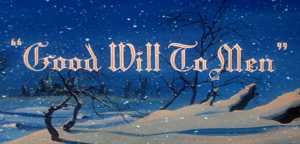 Good Will to Men (MGM, 12/23/55 – William Hanna, Joseph Barbera, dir.) – The world comes to an end. (What, Again?) It’s actually a close remake, of sorts, of Hugh Harman’s “Peace on Earth”, produced in widescreen Cinemascope by Hanna and Barbera. But, unlike several issues of the studio in the widescreen format, it’s not a shot-for-shot retracing of the previous picture, and in fact reuses no animation whatsoever from the original. Nor are the cast members the same. No sign of the squirrel family and old Grandpa. Instead, the tale of the vanishing of the race of men is recounted by an old mouse, who has become the deacon of a parish of choir boy mice, and presides over holiday services for the mice community at the end of the picture.
Good Will to Men (MGM, 12/23/55 – William Hanna, Joseph Barbera, dir.) – The world comes to an end. (What, Again?) It’s actually a close remake, of sorts, of Hugh Harman’s “Peace on Earth”, produced in widescreen Cinemascope by Hanna and Barbera. But, unlike several issues of the studio in the widescreen format, it’s not a shot-for-shot retracing of the previous picture, and in fact reuses no animation whatsoever from the original. Nor are the cast members the same. No sign of the squirrel family and old Grandpa. Instead, the tale of the vanishing of the race of men is recounted by an old mouse, who has become the deacon of a parish of choir boy mice, and presides over holiday services for the mice community at the end of the picture.
 One suspects the decision to produce this film was something dreamed up by the studio front office rather than its directors, who at the time were far more used to producing lively fast-moving comedies. The move for shorts to go with widescreen pictures had driven the studio to convert to all-Cinemascope cartoon production, and management appears to have believed that its old-ratio films would never again be viable subjects for reissue (despite other studios being quite content in showing their old films cropped in matted format to fir the new screens). Thus, nearly as many wide-angle remakes of older films seem to have initially gone into production as newer original titles, with several old Tom and Jerrys (“The Little Orphan”, “Hatch Up Your Troubles”, “Love That Pup”) and even some Avery items (“Wags to Riches”, “Ventriloquit Cat”), receiving a stretch against inferiorly-drawn simplified backgrounds to emulate UPA styling while also saving on budget. Budget was likely the driving factor behind the decision to revive “Peace on Earth” in completely redrawn form rather than a retracing – as any attempt to copy all the artwork from the original masterpiece would have seemed staggering to a studio dealing with contracting budgets. Thus, Hanna and Barbera were likely saddled with the task of this project to provide something to offer for the holiday season. It may be just as well that this project was chosen. Can you imagine how disappointing by comparison a widescreen remake in the simplified animation style of the 1950’s might have looked if the directing team had been ordered to produce a remake of their own past success, 1941’s “The Night Before Christmas”?
One suspects the decision to produce this film was something dreamed up by the studio front office rather than its directors, who at the time were far more used to producing lively fast-moving comedies. The move for shorts to go with widescreen pictures had driven the studio to convert to all-Cinemascope cartoon production, and management appears to have believed that its old-ratio films would never again be viable subjects for reissue (despite other studios being quite content in showing their old films cropped in matted format to fir the new screens). Thus, nearly as many wide-angle remakes of older films seem to have initially gone into production as newer original titles, with several old Tom and Jerrys (“The Little Orphan”, “Hatch Up Your Troubles”, “Love That Pup”) and even some Avery items (“Wags to Riches”, “Ventriloquit Cat”), receiving a stretch against inferiorly-drawn simplified backgrounds to emulate UPA styling while also saving on budget. Budget was likely the driving factor behind the decision to revive “Peace on Earth” in completely redrawn form rather than a retracing – as any attempt to copy all the artwork from the original masterpiece would have seemed staggering to a studio dealing with contracting budgets. Thus, Hanna and Barbera were likely saddled with the task of this project to provide something to offer for the holiday season. It may be just as well that this project was chosen. Can you imagine how disappointing by comparison a widescreen remake in the simplified animation style of the 1950’s might have looked if the directing team had been ordered to produce a remake of their own past success, 1941’s “The Night Before Christmas”?
In the only instance in animation history, lightning struck twice for this production, the only direct remake of a prior Academy Award nominee to receive its own Academy Award nomination. As in the case of its predecessor, it did not win the Oscar. But the sentiments of the academy had again turned full circle – from peace, to war, to peace again. It seems, even to this day, where politics go, the Oscars will follow.
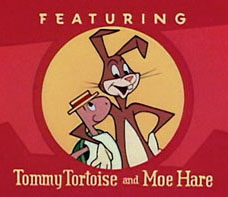 Sleuth But Sure (Paramount/Famous, Noveltoon (Tommy Tortoise and Moe Hare), 3/23/56 – Dave Tendlar, dir.), is most certainly the studio’s homage to Tex Avery, dipping liberally into the formula of Avery’s debut appearance for Droopy, “Dumb Hounded”. Substitute Moe Hare in the role of Avery’s escaping convict wolf, and Tommy as the slow but untiringly relentless law enforcement ever on the trail of the criminal. There is little effort to match the breakneck timing/pacing of the Avery original, but a slower clockwork somehow seems to work well for the studio’s answer to additional Avery creation Cecil Turtle, and results in a respectably funny cartoon with some interesting and memorable gags. One good visual gag appears in the opening escape, when Moe charges a police road block consisting of two cops and two sawhorses placed across the road. The cops and barricades are upset by Moe’s speed, and one sawhorse lands upside down across the other, with the two cops landing on either end of it – resulting in the cops looking like they are left playing a game of see-saw. Moe rides the rods beneath a railroad box car, and pulls out a photograph of his girlfriend, whom he intends to marry now that he has attained his freedom. Moe kisses the portrait so passionately, the picture of his girl now appears with her hair entirely disheveled, and a look on her face that can only register, “Whew!” But Tommy Tortoise, who wears a Sherlock Holmes hat, carries a magnifying glass, yet speaks in the manner of Joe Friday from “Dragnet”, lopes along at a slow trot, somehow finding and catching up with Moe no matter what bursts of speed he puts on and how many means of transportation he employs. A very good and unexpected gag has Moe hop into a sporty sedan and hijack it, taking off at a good clip down the road. He looks up at his rear-view mirror, and sees the image of Tommy, at his usual loping speed, but somehow keeping right up with the vehicle in the mirror. Moe floors the gas pedal, increasing the car’s speed to 200 miles per hour. He looks again – and the view of Tommy in the mirror hasn’t changed a jot.
Sleuth But Sure (Paramount/Famous, Noveltoon (Tommy Tortoise and Moe Hare), 3/23/56 – Dave Tendlar, dir.), is most certainly the studio’s homage to Tex Avery, dipping liberally into the formula of Avery’s debut appearance for Droopy, “Dumb Hounded”. Substitute Moe Hare in the role of Avery’s escaping convict wolf, and Tommy as the slow but untiringly relentless law enforcement ever on the trail of the criminal. There is little effort to match the breakneck timing/pacing of the Avery original, but a slower clockwork somehow seems to work well for the studio’s answer to additional Avery creation Cecil Turtle, and results in a respectably funny cartoon with some interesting and memorable gags. One good visual gag appears in the opening escape, when Moe charges a police road block consisting of two cops and two sawhorses placed across the road. The cops and barricades are upset by Moe’s speed, and one sawhorse lands upside down across the other, with the two cops landing on either end of it – resulting in the cops looking like they are left playing a game of see-saw. Moe rides the rods beneath a railroad box car, and pulls out a photograph of his girlfriend, whom he intends to marry now that he has attained his freedom. Moe kisses the portrait so passionately, the picture of his girl now appears with her hair entirely disheveled, and a look on her face that can only register, “Whew!” But Tommy Tortoise, who wears a Sherlock Holmes hat, carries a magnifying glass, yet speaks in the manner of Joe Friday from “Dragnet”, lopes along at a slow trot, somehow finding and catching up with Moe no matter what bursts of speed he puts on and how many means of transportation he employs. A very good and unexpected gag has Moe hop into a sporty sedan and hijack it, taking off at a good clip down the road. He looks up at his rear-view mirror, and sees the image of Tommy, at his usual loping speed, but somehow keeping right up with the vehicle in the mirror. Moe floors the gas pedal, increasing the car’s speed to 200 miles per hour. He looks again – and the view of Tommy in the mirror hasn’t changed a jot.
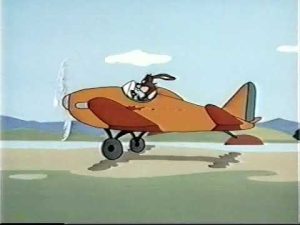 Moe finally turns his head to look back, and discovers the explanation – Tommy is not running on the road, but is atop the sloping trunk of the car, taking simple half-leaps that fail to clear the car’s rear seat, and leave his feet to slide repeatedly down the back side of the trunk until he takes yet another leap. Moe switches to hijacking a plane, and is sure he is all the closer to clear sailing to his lady love. Suddenly, he begins to sink from view out of the open cockpit into the fuselage. From the belly of the plane, bomb bay doors open – and out flies a smaller midget plane which had been concealed inside the fuselage, whose passenger seat had served as a false cockpit for Moe when he entered the larger plane. The real pilot in charge of the smaller plane’s controls is of course, Tommy. Moe makes a leap from the midget plane, using his ears as spinning helicopter blades for a soft landing, and proceeds across a desert. The broiling heat finally gets to him, and he thirsts for water. Ahead, he spies the salvation image of an oasis, with a pool of water visually shimmering in the sunlight. With his last strength, Moe makes a beeline towards it. No, it is not a mirage – yet, it is just as unreal. Moe crashes head first into the still-moving water image, and falls flat on the ground, as the camera pulls back to reveal the mirage is a projected image on a boulder from a movie projector Tommy has concealed behind rocks off to one side. Tommy slaps the cuffs onto Moe’s wrist, and declares the case closed. But Moe slithers out from the cuff the hard way, contorting his entire torso to slip through the metal ring, then flattens Tommy with a boulder. Believing his foe to be eradicated, Tommy arrives at the door of his bride to be, and carries her out in his arms, directly to the doorway of a nearby justice of the peace. As Moe steps inside and the door closes, the entire side of the building falls away – nothing more than a fake front from a Hollywood movie set. Behind the door, Moe finds himself inside the passenger section of a police paddy wagon, the iron door locking behind him. Moe wails for someone to get him a lawyer, while in the driver’s seat sits Tommy, with Moe’s girlfriend seated by his side. Much in the way that Droopy sometimes got the girl, the curvaceous bunny sidles up to Tommy, flirtatiously declaring that she just loves clever little detectives, and plants a kiss on Tommy, who chuckles with embarrassment for the fade out.
Moe finally turns his head to look back, and discovers the explanation – Tommy is not running on the road, but is atop the sloping trunk of the car, taking simple half-leaps that fail to clear the car’s rear seat, and leave his feet to slide repeatedly down the back side of the trunk until he takes yet another leap. Moe switches to hijacking a plane, and is sure he is all the closer to clear sailing to his lady love. Suddenly, he begins to sink from view out of the open cockpit into the fuselage. From the belly of the plane, bomb bay doors open – and out flies a smaller midget plane which had been concealed inside the fuselage, whose passenger seat had served as a false cockpit for Moe when he entered the larger plane. The real pilot in charge of the smaller plane’s controls is of course, Tommy. Moe makes a leap from the midget plane, using his ears as spinning helicopter blades for a soft landing, and proceeds across a desert. The broiling heat finally gets to him, and he thirsts for water. Ahead, he spies the salvation image of an oasis, with a pool of water visually shimmering in the sunlight. With his last strength, Moe makes a beeline towards it. No, it is not a mirage – yet, it is just as unreal. Moe crashes head first into the still-moving water image, and falls flat on the ground, as the camera pulls back to reveal the mirage is a projected image on a boulder from a movie projector Tommy has concealed behind rocks off to one side. Tommy slaps the cuffs onto Moe’s wrist, and declares the case closed. But Moe slithers out from the cuff the hard way, contorting his entire torso to slip through the metal ring, then flattens Tommy with a boulder. Believing his foe to be eradicated, Tommy arrives at the door of his bride to be, and carries her out in his arms, directly to the doorway of a nearby justice of the peace. As Moe steps inside and the door closes, the entire side of the building falls away – nothing more than a fake front from a Hollywood movie set. Behind the door, Moe finds himself inside the passenger section of a police paddy wagon, the iron door locking behind him. Moe wails for someone to get him a lawyer, while in the driver’s seat sits Tommy, with Moe’s girlfriend seated by his side. Much in the way that Droopy sometimes got the girl, the curvaceous bunny sidles up to Tommy, flirtatiously declaring that she just loves clever little detectives, and plants a kiss on Tommy, who chuckles with embarrassment for the fade out.
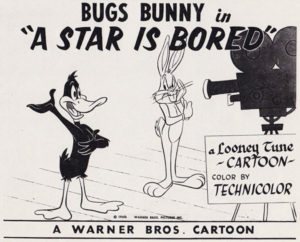 A Star is Bored (Warner, Bugs Bunny, 9/15/56 – Friz Freleng, dir.) – The trials and tribulations of a stunt double had already been documented twice in animation history by the time this film was made. Once in Bob Clampett’s, It’s a Grand Old Nag for Republic, and again by Paul J. Smith, animator on Clampett’s work, in his closely-parallel reworking of the script into A Horse’s Tale for Walter Lantz. This time, a more recognizable face takes on the hazardous chores, as Daffy Duck, studio janitor, decides that if a no-talent rabbit with nothing on the ball can make it big in Hollywood, so can a duck. He lands the position of playing Bugs Bunny’s double in a rabbit suit – a job opening no one else was foolhardy enough to apply for. Daffy learns that Bugs’ on-screen life is chock full of occupational hazards, as he is called upon to take blasts from Yosemite Sam’s six-guns point blank, Elmer Fudd’s rifle in a rabbit-hole booby trap, and even to get swallowed by a giant fish in what he believes is only a peaceful scene of pier fishing. Finally, Bugs is placed in a position similar to his appearance in Hare Lift, but with a more modern jet fighter plane, taking the craft up to 20,000 feet, then into a steep dive. One shot of animation is in fact reused from “Hare Lift”, of Bugs staring at the huge and complicated dashboard panel, while again looking up references in a book on how to fly. The plane zooms toward certain oblivion, but just before ground impact, the director calls out “Cut”, bringing the plane to a standstill just above the ground, then calls for the “Double”. Daffy stammers “D-d-Double?”, never expecting to be substituted into this sequence. A improbble docking link-up is arranged between the frozen plane and a hovering helicopter, meeting at right angles to one another. The cockpit glass of both flying machines pop open. Bugs’ canopy, opening from the rear forward, provides a walkway bridge between his cockpit and that of the helicopter, upon which the bunny and duck pass each other and exchange respective seats. Then, both cockpits close, and the helicopter bearing Bugs flies away. “Action”, calls the director. CRASH!! Out of the rubble of twisted metal crawls a battered Daffy, calling for “Makeup!”
A Star is Bored (Warner, Bugs Bunny, 9/15/56 – Friz Freleng, dir.) – The trials and tribulations of a stunt double had already been documented twice in animation history by the time this film was made. Once in Bob Clampett’s, It’s a Grand Old Nag for Republic, and again by Paul J. Smith, animator on Clampett’s work, in his closely-parallel reworking of the script into A Horse’s Tale for Walter Lantz. This time, a more recognizable face takes on the hazardous chores, as Daffy Duck, studio janitor, decides that if a no-talent rabbit with nothing on the ball can make it big in Hollywood, so can a duck. He lands the position of playing Bugs Bunny’s double in a rabbit suit – a job opening no one else was foolhardy enough to apply for. Daffy learns that Bugs’ on-screen life is chock full of occupational hazards, as he is called upon to take blasts from Yosemite Sam’s six-guns point blank, Elmer Fudd’s rifle in a rabbit-hole booby trap, and even to get swallowed by a giant fish in what he believes is only a peaceful scene of pier fishing. Finally, Bugs is placed in a position similar to his appearance in Hare Lift, but with a more modern jet fighter plane, taking the craft up to 20,000 feet, then into a steep dive. One shot of animation is in fact reused from “Hare Lift”, of Bugs staring at the huge and complicated dashboard panel, while again looking up references in a book on how to fly. The plane zooms toward certain oblivion, but just before ground impact, the director calls out “Cut”, bringing the plane to a standstill just above the ground, then calls for the “Double”. Daffy stammers “D-d-Double?”, never expecting to be substituted into this sequence. A improbble docking link-up is arranged between the frozen plane and a hovering helicopter, meeting at right angles to one another. The cockpit glass of both flying machines pop open. Bugs’ canopy, opening from the rear forward, provides a walkway bridge between his cockpit and that of the helicopter, upon which the bunny and duck pass each other and exchange respective seats. Then, both cockpits close, and the helicopter bearing Bugs flies away. “Action”, calls the director. CRASH!! Out of the rubble of twisted metal crawls a battered Daffy, calling for “Makeup!”
Daffy confronts the head office, demanding his own role instead of taking the rabbit’s lumps. By surprising coincidence, the studio executive has just received the perfect script for Daffy – the lead role in a thrill-packed epic simply entitled, “The Duck.” Filming begins the following morning, as Daffy takes a quick glance at pages of the script hidden below the pond water of a duck pond set to ensure he remembers his lines. “I wonder where all the hunters are today”, he over-emotes. He finds out in a hurry, as eight of them emerge from the duck blinds and open fire. Missing most of his feathers, Daffy demands, in the same manner as in Duck Amuck to know who wrote this script. In the wings, Bugs turns to the audience and states, “I’d like to tell him, but modesty forbids.”
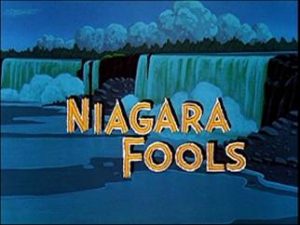 A classic Woody Woodpecker episode, Niagara Fools (Lantz/Universal, 10/22/56 – Paul J. Smith, dir.), previously written about by multiple contributors to this site, receives honorable mention for a brief gag. Woody has taken the notion to follow in the footsteps of past daredevils, and obtain a scenic view of Niagara from the vantage point of a barrel over the falls. A park ranger is determined to prevent this foolhardy stunt, but repeatedly winds up inside the slats himself. When his whole team of rangers gets sent in a watery ride to the Cave of the Winds, they gang up on Woody, seizing from him a new barrel, and sealing him up inside, with postage affixed to send him to the North Pole. Unfortunately, in the scuffle, they’ve sealed up the wrong man, and Woody is left behind unscathed, while the head ranger winds up staring at the polar ice cap. A mad race ensues, as the ranger struggles to get back to the falls before Woody can launch another barrel. As the ranger proceeds ahead with the repeated cry of “Mush!”, his mode of transportation keeps changing – from dog sled, to gondola, and then to airplane, where all we see in the sky is the ranger’s arm pointing from out of the cockpit window, still with the cry, “Mush!” Rest assured, Woody gets to take the ride after all, though the ranger again gets a bath of his own in the process.
A classic Woody Woodpecker episode, Niagara Fools (Lantz/Universal, 10/22/56 – Paul J. Smith, dir.), previously written about by multiple contributors to this site, receives honorable mention for a brief gag. Woody has taken the notion to follow in the footsteps of past daredevils, and obtain a scenic view of Niagara from the vantage point of a barrel over the falls. A park ranger is determined to prevent this foolhardy stunt, but repeatedly winds up inside the slats himself. When his whole team of rangers gets sent in a watery ride to the Cave of the Winds, they gang up on Woody, seizing from him a new barrel, and sealing him up inside, with postage affixed to send him to the North Pole. Unfortunately, in the scuffle, they’ve sealed up the wrong man, and Woody is left behind unscathed, while the head ranger winds up staring at the polar ice cap. A mad race ensues, as the ranger struggles to get back to the falls before Woody can launch another barrel. As the ranger proceeds ahead with the repeated cry of “Mush!”, his mode of transportation keeps changing – from dog sled, to gondola, and then to airplane, where all we see in the sky is the ranger’s arm pointing from out of the cockpit window, still with the cry, “Mush!” Rest assured, Woody gets to take the ride after all, though the ranger again gets a bath of his own in the process.
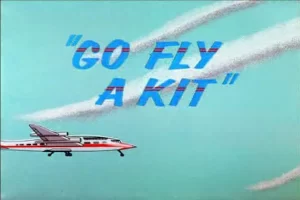 Go Fly a Kit (Warner, 2/16/57, Chuck Jones, dir,). A little charmer, presented in Jones’ unique style. It is more of learning-to-fly cartoon than an airplane cartoon, but just happens to open and close at an airport. There, atop the edge of a fence, a small female cat watches the arrival of each flight, anxiously awaiting one particular landing. In the control tower, one of the workers inquires what that cat is doing up there. A more experienced (and seemingly clairvoyant) flight controller somehow knows the backstory, and answers that she is waiting for her boyfriend. “What’s she in love with? A DC-6?”, asks the first man jokingly. “No, a flying cat”, responds the elder controller. With no explanation as to the source of his knowledge, the story is told in flashback, as the subject boyfriend is adopted as a kitten by an old lady eagle with an over-developed mother instinct, who cares for the kitten in a nest in the high mountains, retrieving milk bottles in her talons to provide the cat with nourishment. When old enough, she attempts to teach the “fledgling” to fly. The kitten is eager to learn, and hops off the cliffside. He streaks straight down, to the mother eagle’s shock, and she dives at full speed to save him. But just before reaching the floor of the canyon below, she is passed by the kitten, on his way back up. Making a U-turn, mother finds her charge has indeed figured out a way to fly – with a spinning tail for a rotor. The eagle applauds him with her talons, and the two affectionately nuzzle in mid-air, beak to cheek.
Go Fly a Kit (Warner, 2/16/57, Chuck Jones, dir,). A little charmer, presented in Jones’ unique style. It is more of learning-to-fly cartoon than an airplane cartoon, but just happens to open and close at an airport. There, atop the edge of a fence, a small female cat watches the arrival of each flight, anxiously awaiting one particular landing. In the control tower, one of the workers inquires what that cat is doing up there. A more experienced (and seemingly clairvoyant) flight controller somehow knows the backstory, and answers that she is waiting for her boyfriend. “What’s she in love with? A DC-6?”, asks the first man jokingly. “No, a flying cat”, responds the elder controller. With no explanation as to the source of his knowledge, the story is told in flashback, as the subject boyfriend is adopted as a kitten by an old lady eagle with an over-developed mother instinct, who cares for the kitten in a nest in the high mountains, retrieving milk bottles in her talons to provide the cat with nourishment. When old enough, she attempts to teach the “fledgling” to fly. The kitten is eager to learn, and hops off the cliffside. He streaks straight down, to the mother eagle’s shock, and she dives at full speed to save him. But just before reaching the floor of the canyon below, she is passed by the kitten, on his way back up. Making a U-turn, mother finds her charge has indeed figured out a way to fly – with a spinning tail for a rotor. The eagle applauds him with her talons, and the two affectionately nuzzle in mid-air, beak to cheek.
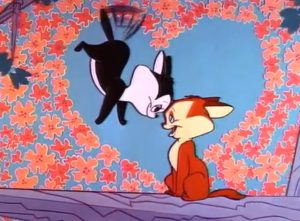 The cat reaches maturity, and the time to strike out from the nest into the world. He lands on some telephone wires, and attempts to make friends with three startled birds, who are so taken aback by hearing the cat’s unexpected meows, they are unable to coordinate a take-off from the wire, continually converging in head-first three-way collisions in their vain attempt to escape. But something of greater interest catches the cat’s eye – a small brown cat (the girl from the opening scenes) being pursued through a park below by an angry bulldog. The male cat bares his claws, and dives down to set things right. He buzzes the bulldog’s back, leaving a path of bare fur up his spine. As the bulldog tries to figure out what hit him, the male grabs hold of the female, and lifts her to the safety of a nearby tree limb, where the panting female briefly rubs foreheads with her rescuer above her, a transparent heart overlay indicating it is love at first sight. But the bulldog remains to be attended to. The cat lands in the middle of the park walkway ahead of the dog, taunting him with a brief yowl and spit. The bulldog charges, while the cat calmly yawns. At the last possible second, he impresses his worrying girlfriend, by revving up his tail and hovering a few feet off the ground, just high enough to get his claws into the bulldog’s back again as he passes. The puzzled dog looks back, slamming on the brakes too late, and falls into the park lake. The dampened dog sneaks out onto the banks, circling around to gain a surprise position of attack upon the cat. The female cat in the tree attempts to warn the male of the dog’s return, but our calm hero just shrugs it off, and sighs fondly at the beauty of the female. Suddenly the dog pounces from nowhere, his image disappearing into a ferocious fight cloud, while the helpless female whimpers in an expression reminiscent of Stan Laurel. Then, rising out of the cloud of dust, the male cat emerges, again using his flying tail, and entirely unhurt from the attle, pointing down humorously at the dog fighting with himself. As the dust settles, the dog is observed violently chomping on someone’s limb.
The cat reaches maturity, and the time to strike out from the nest into the world. He lands on some telephone wires, and attempts to make friends with three startled birds, who are so taken aback by hearing the cat’s unexpected meows, they are unable to coordinate a take-off from the wire, continually converging in head-first three-way collisions in their vain attempt to escape. But something of greater interest catches the cat’s eye – a small brown cat (the girl from the opening scenes) being pursued through a park below by an angry bulldog. The male cat bares his claws, and dives down to set things right. He buzzes the bulldog’s back, leaving a path of bare fur up his spine. As the bulldog tries to figure out what hit him, the male grabs hold of the female, and lifts her to the safety of a nearby tree limb, where the panting female briefly rubs foreheads with her rescuer above her, a transparent heart overlay indicating it is love at first sight. But the bulldog remains to be attended to. The cat lands in the middle of the park walkway ahead of the dog, taunting him with a brief yowl and spit. The bulldog charges, while the cat calmly yawns. At the last possible second, he impresses his worrying girlfriend, by revving up his tail and hovering a few feet off the ground, just high enough to get his claws into the bulldog’s back again as he passes. The puzzled dog looks back, slamming on the brakes too late, and falls into the park lake. The dampened dog sneaks out onto the banks, circling around to gain a surprise position of attack upon the cat. The female cat in the tree attempts to warn the male of the dog’s return, but our calm hero just shrugs it off, and sighs fondly at the beauty of the female. Suddenly the dog pounces from nowhere, his image disappearing into a ferocious fight cloud, while the helpless female whimpers in an expression reminiscent of Stan Laurel. Then, rising out of the cloud of dust, the male cat emerges, again using his flying tail, and entirely unhurt from the attle, pointing down humorously at the dog fighting with himself. As the dust settles, the dog is observed violently chomping on someone’s limb.
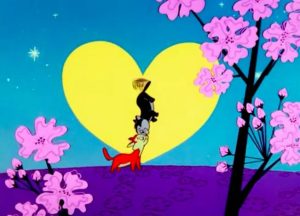 It turns out to be his own foot, which the dog attempts to self-cure from its bent and battered condition, by gently kissing the boo-boo. The cat now playfully lands atop the dog’s head, calmly preening himself. The bulldog grabs a club, and attempts to bash the cat – only succeeding in landing a powerful blow upon his own head, while the cat rises out of range as the club is swung. The process is repeated several times over, until the groggy bulldog finds the cat now sitting atop the end of his club. The dog throws the club, but the cat remains in place with a rotor-tail hover, then yowls directly behind the dog’s head, spooking him into a jump upon some park trash cans. Grabbing a can, the dog leaps into the air, coming down with the can atop the cat, trapping him between the can and the ground. The dog remains on top of the can, snickering at having finally foiled the cat’s secret power. But a whirl of air slowly lifts the can from the ground, as the spinning sound of the cat’s tail is heard inside the can. The dog finds himself and the can rising, rising, and there is nothing to do but to hang onto the can as it continues to climb. The can and cat make slow and steady progress all the way up to the flagpole atop the pinnacle of the city’s tallest skyscraper, where the can is neatly deposited upside down atop the flagpole, while the cat flies out from underneath. The dog is left clinging to the top of the can, which, as it is wider in diameter than the pole, suddenly tips to one side. The dog is nearly thrown off, and shifts weight in the opposite direction – only causing the can to tip te opposite way. The shaking dog plants himself atop the can, attempting to perform a never-ceasing balancing act to keep the can centered, which goes on indefinitely into the dark of evening, the periodic metallc shifting of the can heard from a distance far below. The female is brought down from the tree, and the two cats court in the moonlit park. Our scene dissolves back to the present and the airport, where the flight controller explains that each spring, the male cat flies South for the winter, and the female awaits his return. High above, the flying cat appears in the sky, and makes his approach towad the runway. Setting his legs into rotating motion like wheels, the cat makes a perfect four-point landing, then rises to the top of the fence where his lady love waits. The two nuzzle forehead to forehead, while the female springs a surprise. From her side of the fence, four flying kittens (two male, two female) rise to look down upon their parents below, then each pair off in a head to head affectionate nuzzle matching their elders, for the fade out.
It turns out to be his own foot, which the dog attempts to self-cure from its bent and battered condition, by gently kissing the boo-boo. The cat now playfully lands atop the dog’s head, calmly preening himself. The bulldog grabs a club, and attempts to bash the cat – only succeeding in landing a powerful blow upon his own head, while the cat rises out of range as the club is swung. The process is repeated several times over, until the groggy bulldog finds the cat now sitting atop the end of his club. The dog throws the club, but the cat remains in place with a rotor-tail hover, then yowls directly behind the dog’s head, spooking him into a jump upon some park trash cans. Grabbing a can, the dog leaps into the air, coming down with the can atop the cat, trapping him between the can and the ground. The dog remains on top of the can, snickering at having finally foiled the cat’s secret power. But a whirl of air slowly lifts the can from the ground, as the spinning sound of the cat’s tail is heard inside the can. The dog finds himself and the can rising, rising, and there is nothing to do but to hang onto the can as it continues to climb. The can and cat make slow and steady progress all the way up to the flagpole atop the pinnacle of the city’s tallest skyscraper, where the can is neatly deposited upside down atop the flagpole, while the cat flies out from underneath. The dog is left clinging to the top of the can, which, as it is wider in diameter than the pole, suddenly tips to one side. The dog is nearly thrown off, and shifts weight in the opposite direction – only causing the can to tip te opposite way. The shaking dog plants himself atop the can, attempting to perform a never-ceasing balancing act to keep the can centered, which goes on indefinitely into the dark of evening, the periodic metallc shifting of the can heard from a distance far below. The female is brought down from the tree, and the two cats court in the moonlit park. Our scene dissolves back to the present and the airport, where the flight controller explains that each spring, the male cat flies South for the winter, and the female awaits his return. High above, the flying cat appears in the sky, and makes his approach towad the runway. Setting his legs into rotating motion like wheels, the cat makes a perfect four-point landing, then rises to the top of the fence where his lady love waits. The two nuzzle forehead to forehead, while the female springs a surprise. From her side of the fence, four flying kittens (two male, two female) rise to look down upon their parents below, then each pair off in a head to head affectionate nuzzle matching their elders, for the fade out.
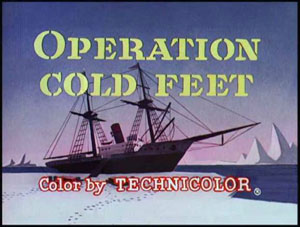 Operation Cold Feet (Lantz/Universal, Chilly Willy, 5/6/57 – Alex Lovy, dir.), receives only brief honorable mention. At an Antarctic military base, sentry Smedly, the southern-accented St. Bernard, marches on patrol duty, and also announces to the Admiral that his plane is ready for take-off. Breaking the fourth wall, Smedly lets us in on the fact that his superior officer is none other than Admiral Bird. The camera pans over to the officer, who reveals his face – a long-beaked bird of true avian variety, who flexes his eyebrows photogenically at the camera. Unseen to the audience, we hear the sound of the Admiral’s plane taking off, while Smedly’s eyes follow its progress. Smedly unfortunately stands too close to the runway, and the speed of the departing plane’s wheels kicks up enough snow to transform the dog into an instant snowman. The remainder of the film portrays a classic battle over the food storage warehouse, loaded with K-rations consisting of sardines. Chilly obtains his fill as usual – guaranteeing no empty space in his gullet by loading himself with the salty sea fare with the use of a vacuum cleaner motor set in reverse.
Operation Cold Feet (Lantz/Universal, Chilly Willy, 5/6/57 – Alex Lovy, dir.), receives only brief honorable mention. At an Antarctic military base, sentry Smedly, the southern-accented St. Bernard, marches on patrol duty, and also announces to the Admiral that his plane is ready for take-off. Breaking the fourth wall, Smedly lets us in on the fact that his superior officer is none other than Admiral Bird. The camera pans over to the officer, who reveals his face – a long-beaked bird of true avian variety, who flexes his eyebrows photogenically at the camera. Unseen to the audience, we hear the sound of the Admiral’s plane taking off, while Smedly’s eyes follow its progress. Smedly unfortunately stands too close to the runway, and the speed of the departing plane’s wheels kicks up enough snow to transform the dog into an instant snowman. The remainder of the film portrays a classic battle over the food storage warehouse, loaded with K-rations consisting of sardines. Chilly obtains his fill as usual – guaranteeing no empty space in his gullet by loading himself with the salty sea fare with the use of a vacuum cleaner motor set in reverse.
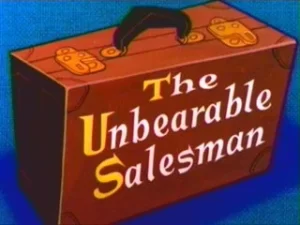 The Unbearable Salesman (Lantz/Universal, Woody Woodpecker, 6/3/57 – Paul J. Smith, dir.) – Woody relates to the kids Knothead and Splinter how he acquired an old bearskin rug in his living room. The encounter with the critter happened while Woody was pursuing the career of a traveling salesman. At the first sign of winter (a single snowflake which falls upon the bear’s nose), a woodland bear knows it’s time to head for hibernation. He does so in a hurry, beating a zig-zag path of dust over the hills to his cave. (Watch this shot closely, as Smith pulls off a total cheat by reusing animation from another series – the running character is not the bear at all, but a stock shot of Smedly running from the Chilly Willy series’ Hold That Rock.) Unfortunately for the bear, Woody shows up on his doorstep, as aggravating and unavoidable a sales-pitcher as Daffy Duck in The Stupor Salesman, with a seemingly endless line of useles products for sale. Everything from oversize false teeth, to eyelid inserts with pictures of beautiful girls on them (to produce joyful dreams – until they slap you for getting fresh), to a nightshirt with a built-in shower. The bear reaches the breaking point, and makes several attempts to dispose of the woodpecker (including dropping him into the lake inside a locked safe, a guillotine, etc.) One such attempt has the bear believing he has Woody tied in a sack, and flying high in a plane with intent to drop the sack overboard. But Woody has already escaped again, and appears in the passenger seat of the same plane. In the same coy manner as Bugs Bunny, Woody inquires as to the content of the sack. When told it contains a pesky woodpecker, Woody asks for a description of what the captured bird looks like. “Oh, he’s about your size – no moustache – talks too much – red hair – yellow feet – no moustache…”, rambles the bear. Woody meanwhile has notices a button on the plane’s dashboard marked “Ejector seat”. He pushes it, and the bear jettisons toward the ground, failing to notice any change of position, and continuing uninterrupted in his description of the bird. Woody follows him through the sky with a small parachute, taking hold of the top of the bear’s ejected seat. “Pardon me. Is this seat taken?”, asks Woody, then pulls out the seat from under the bear. The bruin falls helplessly, as Woody looks on with a smile.
The Unbearable Salesman (Lantz/Universal, Woody Woodpecker, 6/3/57 – Paul J. Smith, dir.) – Woody relates to the kids Knothead and Splinter how he acquired an old bearskin rug in his living room. The encounter with the critter happened while Woody was pursuing the career of a traveling salesman. At the first sign of winter (a single snowflake which falls upon the bear’s nose), a woodland bear knows it’s time to head for hibernation. He does so in a hurry, beating a zig-zag path of dust over the hills to his cave. (Watch this shot closely, as Smith pulls off a total cheat by reusing animation from another series – the running character is not the bear at all, but a stock shot of Smedly running from the Chilly Willy series’ Hold That Rock.) Unfortunately for the bear, Woody shows up on his doorstep, as aggravating and unavoidable a sales-pitcher as Daffy Duck in The Stupor Salesman, with a seemingly endless line of useles products for sale. Everything from oversize false teeth, to eyelid inserts with pictures of beautiful girls on them (to produce joyful dreams – until they slap you for getting fresh), to a nightshirt with a built-in shower. The bear reaches the breaking point, and makes several attempts to dispose of the woodpecker (including dropping him into the lake inside a locked safe, a guillotine, etc.) One such attempt has the bear believing he has Woody tied in a sack, and flying high in a plane with intent to drop the sack overboard. But Woody has already escaped again, and appears in the passenger seat of the same plane. In the same coy manner as Bugs Bunny, Woody inquires as to the content of the sack. When told it contains a pesky woodpecker, Woody asks for a description of what the captured bird looks like. “Oh, he’s about your size – no moustache – talks too much – red hair – yellow feet – no moustache…”, rambles the bear. Woody meanwhile has notices a button on the plane’s dashboard marked “Ejector seat”. He pushes it, and the bear jettisons toward the ground, failing to notice any change of position, and continuing uninterrupted in his description of the bird. Woody follows him through the sky with a small parachute, taking hold of the top of the bear’s ejected seat. “Pardon me. Is this seat taken?”, asks Woody, then pulls out the seat from under the bear. The bruin falls helplessly, as Woody looks on with a smile.
Eventually, Woody is seen tied up in rope, surrounded by a circle of lighted cannons. The bear stands to one side with fingers in his ears, awaiting the explosion – only to look up, and find the cannons now repositioned around him. KAPOW! The scene dissolves back to Woody’s living room, as he concludes, “And that’s how I got the bearskin rug”. The kids wish Woody good night, and go up to their room – but not before also saying good night to the rug, where the bear, still very much alive, curls up for the long siesta that Woody still owes him. A cold wooden floor will suit him just fine, after all he’s been through.
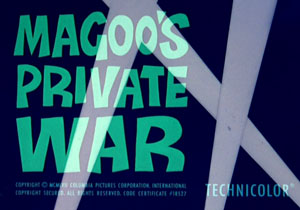 Magoo’s Private War (UPA/Columbia, Mr. Magoo, 12/19/57 – Rudy Larriva, dir.) – What dunderheaded peabrain would appoint the likes of Magoo a disaster warden? Maybe it’s a volunteer position, but Magoo’s only practical experience to qualify would be physical presence at the disasters he has created himself. Nevertheless, Magoo is in charge of local civil defense, and throws himself into his new responsibility with fervor and gusto. On his first night of patrol, he encounters a youth racing across his path. Magoo of course gets turned around, and carries on his conversation with a fire hydrant, but hears the excited child yelling, “It’s starting! Invasion From Space!” He is referring to a big premiere at the local movie house, complete with rocket balloon out front, and celebrities posing as spacemen. Seeing the searchlights outside, Magoo is convinced the real thing is in progress, and takes charge. He knocks down one of the space-suit attired dignitaries, telling others to stand back as he is probably radioactive. He trods over a worker preparing wet cement for the stars’ footprints, pressing him face-first into the pavement. Another little boy on the sidelines holds out an autograph book to Magoo, thinking him one of the celebrities. Magoo grabs the pen, and quickly scribbles on the page, “Send troops”, then tells the boy he must get the message through – “You’re expendable.”
Magoo’s Private War (UPA/Columbia, Mr. Magoo, 12/19/57 – Rudy Larriva, dir.) – What dunderheaded peabrain would appoint the likes of Magoo a disaster warden? Maybe it’s a volunteer position, but Magoo’s only practical experience to qualify would be physical presence at the disasters he has created himself. Nevertheless, Magoo is in charge of local civil defense, and throws himself into his new responsibility with fervor and gusto. On his first night of patrol, he encounters a youth racing across his path. Magoo of course gets turned around, and carries on his conversation with a fire hydrant, but hears the excited child yelling, “It’s starting! Invasion From Space!” He is referring to a big premiere at the local movie house, complete with rocket balloon out front, and celebrities posing as spacemen. Seeing the searchlights outside, Magoo is convinced the real thing is in progress, and takes charge. He knocks down one of the space-suit attired dignitaries, telling others to stand back as he is probably radioactive. He trods over a worker preparing wet cement for the stars’ footprints, pressing him face-first into the pavement. Another little boy on the sidelines holds out an autograph book to Magoo, thinking him one of the celebrities. Magoo grabs the pen, and quickly scribbles on the page, “Send troops”, then tells the boy he must get the message through – “You’re expendable.”
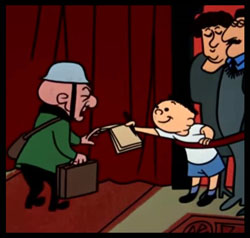 Inside the theater, an usher attempts to check for Magoo’s ticket. Noting his uniform, Magoo assumes him a military man, and shouts, “All leaves cancelled, lieutenant, until I contact headquarters.” Magoo ducks among the seats in the darkened theater, and tries to get a message through on his walkie-talkie. In front of him, on the screen, a widescreen newsreel has begun, and a narrator’s voice refers to military operations being conducted by a General Clayburger. Magoo believes the voice is on the other end of his communicator, and asks what are the General’s orders. But before he can find out, live-action footage is woven integrally with the animation, depicting jet fighters firing missiles and rocket weaponry. Magoo believes a wave of invaders is attacking full force. The usher catches up to him with a flashlight. “Douse that light”, yells Magoo, tossing the flashlight away over the seating to the opposite aisle. The usher crosses through the seating to retrieve his light, while Magoo observes screen imagery of a structure in flames from the missile attack. Magoo at first ducks for cover, coming up undereath a seated woman, who faints at the masher getting a free show of his own. Magoo meawhile refers to the screen images as a “holocaust”, and produces a water pump from nowhere to try to put out the screen fire. Returning to his walkie talkie, Magoo encounters the usher returning with his flashlight. Accusing the “lieutenant” of insubordination, Magoo again insists that the light be doused, and smashes the flashlight flat.
Inside the theater, an usher attempts to check for Magoo’s ticket. Noting his uniform, Magoo assumes him a military man, and shouts, “All leaves cancelled, lieutenant, until I contact headquarters.” Magoo ducks among the seats in the darkened theater, and tries to get a message through on his walkie-talkie. In front of him, on the screen, a widescreen newsreel has begun, and a narrator’s voice refers to military operations being conducted by a General Clayburger. Magoo believes the voice is on the other end of his communicator, and asks what are the General’s orders. But before he can find out, live-action footage is woven integrally with the animation, depicting jet fighters firing missiles and rocket weaponry. Magoo believes a wave of invaders is attacking full force. The usher catches up to him with a flashlight. “Douse that light”, yells Magoo, tossing the flashlight away over the seating to the opposite aisle. The usher crosses through the seating to retrieve his light, while Magoo observes screen imagery of a structure in flames from the missile attack. Magoo at first ducks for cover, coming up undereath a seated woman, who faints at the masher getting a free show of his own. Magoo meawhile refers to the screen images as a “holocaust”, and produces a water pump from nowhere to try to put out the screen fire. Returning to his walkie talkie, Magoo encounters the usher returning with his flashlight. Accusing the “lieutenant” of insubordination, Magoo again insists that the light be doused, and smashes the flashlight flat.
The usher heads to the lobby for a new flashlight, while the screen depicts waves of paratroopers diving in. More invaders, thinks Magoo. The usher returns, but trips over Magoo in the aisle, falling flat on his face. “Poor devil, He never had a chance”, mutters Magoo. By the next cutaway to the paratroopers, Magoo has pulled out his first aid kit, and has the usher bound up like a mummy in surgical bandages. Finally, the screen depicts the approach of battleships opening fire, and Magoo believes the General’s reinforcements have arrived. A rocket is seen launching on the screen, and Magoo is certain it’s all over but the shouting – that the invaders have been beaten back to their home planet. Magoo tosses any stray object he can at the departing rocket, charging the screen – and disappears right through it, into the back wings of the theater. He exits through the stage door into an alley, and believes the city lights have come back on again, as he shouts a few final epithets at the skies that we’ll make things plenty hot for the invaders if they ever decide to return. Finding what he thinks is a police phone on a pole, Magoo calls in a report of “all clear” – not realizing he has really activated a fire alarm box. As the sound of approaching engines is heard, Magoo yells “Great balls of fire! Another emergency! Magoo in charge again. Volunteers!”, and runs down the street toward his next adventure.
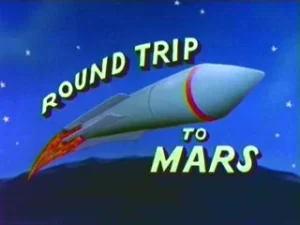 Round Trip to Mars (Lantz/Universal, Woody Woodpecker, 9/23/57 – Paul J. Smith, dir.) – At the desert resort of “Lost Wages”, Woody attempts to lounge on a floatation ring in a swimming pool – until the peace and quiet is shattered by the sound of a rivet gun being used at a nearby proving grounds, where a rocket is being completed in final construction. It is Professor Dingledong manning the rivet gun, and announcing his intention to be the first man to fly to Mars. Woody decides to put a stop to this madness, by hooking the rocket’s fin to a large boulder with a rubber innertube. Dingledong enters the cockpit of his craft, counts down, and takes off – only to be dragged back to the ground by the boulder for a crash landing. Though the landing was rough, Dingledong is convinced that he made it – especially when he opens the door, and encounters Woody, having fun with him by holding up a sign saying, “Welcome to Mars”. “Ookie bookie ick ick” chatters Woody. “The natives are friendly”, concludes Dingledong. But Dinhgledong wants to bring back proof of his journey, and decides to capture Woody as a specimen. A nutty chase is therefore on.
Round Trip to Mars (Lantz/Universal, Woody Woodpecker, 9/23/57 – Paul J. Smith, dir.) – At the desert resort of “Lost Wages”, Woody attempts to lounge on a floatation ring in a swimming pool – until the peace and quiet is shattered by the sound of a rivet gun being used at a nearby proving grounds, where a rocket is being completed in final construction. It is Professor Dingledong manning the rivet gun, and announcing his intention to be the first man to fly to Mars. Woody decides to put a stop to this madness, by hooking the rocket’s fin to a large boulder with a rubber innertube. Dingledong enters the cockpit of his craft, counts down, and takes off – only to be dragged back to the ground by the boulder for a crash landing. Though the landing was rough, Dingledong is convinced that he made it – especially when he opens the door, and encounters Woody, having fun with him by holding up a sign saying, “Welcome to Mars”. “Ookie bookie ick ick” chatters Woody. “The natives are friendly”, concludes Dingledong. But Dinhgledong wants to bring back proof of his journey, and decides to capture Woody as a specimen. A nutty chase is therefore on.
 After numerous corny traps and pursuit gags, Dingledong wails at being unable to capture the space man. “I can’t stand to see an Earth man cry”, responds Woody, who relents to accompany Dingledong back to Earth. However, with Dingledong’s rocket in a battered condition, Woody volunteers to take the two of them back in his own private rocket ship. He directs the professor to a craft that looks more like a blue plane, and they both climb into the cockpit. Looking at his watch, Woody counts a count-down, then yells, “Blast off.” On cue, the craft begins to move. But it only gains minimal elevation as it speeds ahead. Woody has taken the professor onto an amusement park airplane ride, where a ring of planes circle a central pole, atop which is mounted a sign with the park’s name printed upon it – “Dizzyland”.
After numerous corny traps and pursuit gags, Dingledong wails at being unable to capture the space man. “I can’t stand to see an Earth man cry”, responds Woody, who relents to accompany Dingledong back to Earth. However, with Dingledong’s rocket in a battered condition, Woody volunteers to take the two of them back in his own private rocket ship. He directs the professor to a craft that looks more like a blue plane, and they both climb into the cockpit. Looking at his watch, Woody counts a count-down, then yells, “Blast off.” On cue, the craft begins to move. But it only gains minimal elevation as it speeds ahead. Woody has taken the professor onto an amusement park airplane ride, where a ring of planes circle a central pole, atop which is mounted a sign with the park’s name printed upon it – “Dizzyland”.
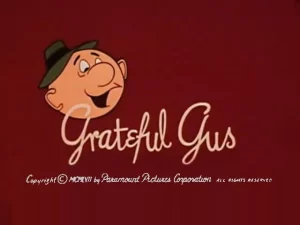 Grateful Gus (Paramount/Famous, Noveltoon, 3/7/58) – Dave Tendlar, dir.) – I am unaware of any write-ups as to the precise reasons for Dave Tendlar’s decision to jump ship from Paramount and make the move across town to Terrytoons, now CBS-owned. However, the timing of the move is probably telling. Paramount was on the wane, big time, and its budgets were being slashed. It seemed to be getting harder and harder to present a competent story under the financial pressure – and Tendlar was rarely one to let the front office interfere with his ability to tell a tale. Despite the previous lowly reputation of Terrytoons under Terry’s management, Tendlar may actually have seen the prospects of increased freedom and reveues in moving over to CBS, above anything Paramount’s management would continue to offer. The move seems to have been a wise one – as Tendlar’s tenure at CBS would prove successful, allowing him to create new characters (particularly, his influence on the Hector Heathcote series) and work wth other new collaborative creations such as Deputy Dawg, along with occasional revisits to simplified versions of the classic Terry characters – all with a strong story sense. Grateful Gus would be Tendlar’s last production for Paramount – and Tendlar did not disappoint, closing out his career with a strong story line and a memorable one-shot character.
Grateful Gus (Paramount/Famous, Noveltoon, 3/7/58) – Dave Tendlar, dir.) – I am unaware of any write-ups as to the precise reasons for Dave Tendlar’s decision to jump ship from Paramount and make the move across town to Terrytoons, now CBS-owned. However, the timing of the move is probably telling. Paramount was on the wane, big time, and its budgets were being slashed. It seemed to be getting harder and harder to present a competent story under the financial pressure – and Tendlar was rarely one to let the front office interfere with his ability to tell a tale. Despite the previous lowly reputation of Terrytoons under Terry’s management, Tendlar may actually have seen the prospects of increased freedom and reveues in moving over to CBS, above anything Paramount’s management would continue to offer. The move seems to have been a wise one – as Tendlar’s tenure at CBS would prove successful, allowing him to create new characters (particularly, his influence on the Hector Heathcote series) and work wth other new collaborative creations such as Deputy Dawg, along with occasional revisits to simplified versions of the classic Terry characters – all with a strong story sense. Grateful Gus would be Tendlar’s last production for Paramount – and Tendlar did not disappoint, closing out his career with a strong story line and a memorable one-shot character.
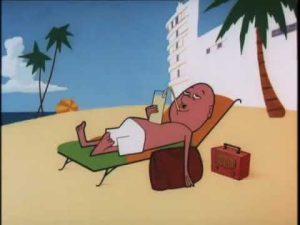 Almost all dialogue in the film (with the exception of a cop and a radio announcer) is provided by the title character – in a voice unfamiliar to Paramount fans, which seems exceptionally well-trained and professional in emotional inflection, comic timing, and natural feel. Who is the mystery man? A surprise celebrity appearance, by a man who would become well-recognized in the animation field – but only years later in the medium of television. In fact, his reputation to audiences among whom he had become something of a household word was also cemented into the medium of the small screen, where he had literally stood out among a crowd among a talented “troop” of performers, in one of the highest-rated and celebrated comedy series of the day. The man was Maurice Gosfield – and the series that catapulted him to fame was The Phil Silvers Show” (aka “You’ll Never Get Rich” or “Sergeant Bilko”), where he memorably played the lowest of buck privates, a loveable slob named Doberman. His character would have an animation crossover in Bob McKimson’s “Dog Tales” (Warner, 1958), which includes a Doberman Pinscher pinching Doberman. However, Gosfield himself would be best remembered in the industry for a season at Hanna-Barbera, providing the unforgettable voicing of Benny the Ball, in counterpart to his own Doberman role, in the animated knock-off of Bilko’s platoon, “Top Cat”. It is unknown if Gosfield had had any prior experience in animated voice-over before “Grateful Gus” (perhaps in some commercial campaign). The film appears, however, to be his only theatrical cartoon, and a rare chance to hear his reads in a more normal “street voice”, not putting on the raspiness and higher-pitched wheezings of either Doberman or Benny the Ball. It is for this reason that the voice was difficult to place – although the skill of his readings comes shining through, so that once you are aware who is behind the voice, recognizable traits of sincerity and believability in playing a schlemiel are readily evident.
Almost all dialogue in the film (with the exception of a cop and a radio announcer) is provided by the title character – in a voice unfamiliar to Paramount fans, which seems exceptionally well-trained and professional in emotional inflection, comic timing, and natural feel. Who is the mystery man? A surprise celebrity appearance, by a man who would become well-recognized in the animation field – but only years later in the medium of television. In fact, his reputation to audiences among whom he had become something of a household word was also cemented into the medium of the small screen, where he had literally stood out among a crowd among a talented “troop” of performers, in one of the highest-rated and celebrated comedy series of the day. The man was Maurice Gosfield – and the series that catapulted him to fame was The Phil Silvers Show” (aka “You’ll Never Get Rich” or “Sergeant Bilko”), where he memorably played the lowest of buck privates, a loveable slob named Doberman. His character would have an animation crossover in Bob McKimson’s “Dog Tales” (Warner, 1958), which includes a Doberman Pinscher pinching Doberman. However, Gosfield himself would be best remembered in the industry for a season at Hanna-Barbera, providing the unforgettable voicing of Benny the Ball, in counterpart to his own Doberman role, in the animated knock-off of Bilko’s platoon, “Top Cat”. It is unknown if Gosfield had had any prior experience in animated voice-over before “Grateful Gus” (perhaps in some commercial campaign). The film appears, however, to be his only theatrical cartoon, and a rare chance to hear his reads in a more normal “street voice”, not putting on the raspiness and higher-pitched wheezings of either Doberman or Benny the Ball. It is for this reason that the voice was difficult to place – although the skill of his readings comes shining through, so that once you are aware who is behind the voice, recognizable traits of sincerity and believability in playing a schlemiel are readily evident.
 Aboard a plane, the teller is found seated and wearing a Halloween masic to remain incognito. He rises to go to the restroom, and is amazingly met by Gus coming out. How did Gus sneak on board, or afford a ticket on a measly ten bucks? Maybe that’s all it costs to fly inside the rest room. Gus repeats following the teller up and down the aisle, also removing the teller’s mask with the comment, “Don’t hide that bright and honest face of yours.” When Gus comments aloud at how generous the teller is with his “hard-earned money”, the teller can endure the risk no longer, and opens a porthole window to dump Gus out of the plane. But Gus cannot be disposed of that easily. Some time later, as the teller lounges on a sunny beach. Gus washes ashore in a random wave, rolling right up to the teller and stating. “You forgot your sun tan oil. He begins vigorously applying the lotion to the teller’s chest, his hands moving like a drummer along the teller’s hollow abdomen, causing Gus to comment at his own drum beats, “My, but the natives are restless tonight.”
Aboard a plane, the teller is found seated and wearing a Halloween masic to remain incognito. He rises to go to the restroom, and is amazingly met by Gus coming out. How did Gus sneak on board, or afford a ticket on a measly ten bucks? Maybe that’s all it costs to fly inside the rest room. Gus repeats following the teller up and down the aisle, also removing the teller’s mask with the comment, “Don’t hide that bright and honest face of yours.” When Gus comments aloud at how generous the teller is with his “hard-earned money”, the teller can endure the risk no longer, and opens a porthole window to dump Gus out of the plane. But Gus cannot be disposed of that easily. Some time later, as the teller lounges on a sunny beach. Gus washes ashore in a random wave, rolling right up to the teller and stating. “You forgot your sun tan oil. He begins vigorously applying the lotion to the teller’s chest, his hands moving like a drummer along the teller’s hollow abdomen, causing Gus to comment at his own drum beats, “My, but the natives are restless tonight.”
 Everywhere the teller goes, and despite every method to rid himself of the pest, Gus appears as predictably as Droopy, with more compliments and attempts at goof deeds. Gus even appears on a platter served in the hotel restaurant, inside the mouth of a huge fish head, informing the teller, “The swordfish is very nice, but be careful of the bones.” A passing police parade leaves the teller huddled behind a telephone pole in fear – just as Gus appears, bearing a wanted poster with the teller’s image, to compliment him upon how photogenic he is. “You don’t believe me? Let’s get someone else’s opinion.” Gus steps over to one of the marching cops. “Answer me yes or no. Should he be in the movies of not?”, asks Gus, pointing the cops’ attention to the trembling teller. Gunshots fly from the cops’ revolvers, and the police ambush the teller offscreen, Gus cringing and wincing at every act of violence they inflict upon his beloved master. As the teller, nattered and bruised, is dragged away, Gus pleads to the cops to show him mercy – until a cop hands Gus a gat wad of bills, as reward for the criminal’s capture. “You’re a NICE man too”, responds Gus – and the whole process begins again, as Gus places the puzzled cop’s foot upon his head for a shoe shine, with the repeated inquiry, “What can I do for you? Your wish is my command.”
Everywhere the teller goes, and despite every method to rid himself of the pest, Gus appears as predictably as Droopy, with more compliments and attempts at goof deeds. Gus even appears on a platter served in the hotel restaurant, inside the mouth of a huge fish head, informing the teller, “The swordfish is very nice, but be careful of the bones.” A passing police parade leaves the teller huddled behind a telephone pole in fear – just as Gus appears, bearing a wanted poster with the teller’s image, to compliment him upon how photogenic he is. “You don’t believe me? Let’s get someone else’s opinion.” Gus steps over to one of the marching cops. “Answer me yes or no. Should he be in the movies of not?”, asks Gus, pointing the cops’ attention to the trembling teller. Gunshots fly from the cops’ revolvers, and the police ambush the teller offscreen, Gus cringing and wincing at every act of violence they inflict upon his beloved master. As the teller, nattered and bruised, is dragged away, Gus pleads to the cops to show him mercy – until a cop hands Gus a gat wad of bills, as reward for the criminal’s capture. “You’re a NICE man too”, responds Gus – and the whole process begins again, as Gus places the puzzled cop’s foot upon his head for a shoe shine, with the repeated inquiry, “What can I do for you? Your wish is my command.”
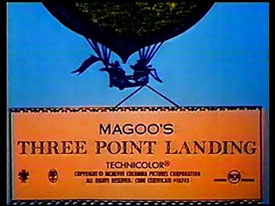 Magoo’s Three Point Landing (UPA/Columbia, Mr. Magoo, 6/5/58 – Pete Burness, dir.) – After a long evening drive, Magoo’s old jalopy’s engine is acting up, stalling and sputtering, its rattling seeming to be the only thing keeping Magoo awake at the wheel. Magoo searches the roadside for signs of possible assistance, and believes he has found a service garage open late-night. Of course, what he is driving into is the service hangar of a local airport. Encountering a crew of mechanics on the wings and tail of a pair of planes, Magoo introduces himself, and informs them that something is wrong with his combustion – it’s not combusting. “Get this crate outta here”, snarls a chief mechanic. Magoo is insulted at anyone calling his fine automobile a “crate”, and accuses the mechanics of being too rich to provide service to the likes of him. Magoo states he’ll take his business elsewhere, so that the mechanics can spend their time working on those “new cars, with their outlandish fins”, pointing to the tail section of one of the planes. Magoo proceeds forward, exiting at full speed, taking the nose section right off one of the planes, and rolling out the other side of the hangar onto the runway. Magoo rolls up the ramp of and through the body of a larger plane, emerging from a nose ramp pushing a string of passengers along ahead of him in their seats. Entering another hangar, he makes a left turn, leaving the passengers behind, and taxis out onto the main runway strip. A headlight from an approaching plane temporarily blinds Magoo (isn’t he almost blind anyway?), leaving him shouting at the “driver” to dim his lights before he runs someone into a ditch. Then, Magoo’s engine sputs its last sputter, and dies in the middle of the field. Magoo checks to see if he’s out of gas, but inserts his dip stick into a thermos bottle instead of the gas tank, so is convinced he still has plenty of fuel. Magoo stoops to lower himself to the pitiful position of thumbing a ride from a passing motorist. However, the only vehicles passing him are planes in the process of takeoff. Their lights pass dangerously close, causing Magoo to duck with just barely enough clearance to miss collision from the huge tires of the landing gear. Magoo can’t believe that he is being regularly passed up and nearly hit, without one motorist showing common courtesy for a stranded fellow driver. He shouts at the planes, “Well, thanks a million! I hope to see you broken down along the road someday.” A fast jet taxis into position, while Magoo, wondering if the drivers haven’t been able to see him, waves his coat out in front of him to get attention. The jet passes so close, its wing snags the coat away, leaving only a torn remnant in Magoo’s hand. Magoo curses the young “hot-rodder” who just ruined his best coat.
Magoo’s Three Point Landing (UPA/Columbia, Mr. Magoo, 6/5/58 – Pete Burness, dir.) – After a long evening drive, Magoo’s old jalopy’s engine is acting up, stalling and sputtering, its rattling seeming to be the only thing keeping Magoo awake at the wheel. Magoo searches the roadside for signs of possible assistance, and believes he has found a service garage open late-night. Of course, what he is driving into is the service hangar of a local airport. Encountering a crew of mechanics on the wings and tail of a pair of planes, Magoo introduces himself, and informs them that something is wrong with his combustion – it’s not combusting. “Get this crate outta here”, snarls a chief mechanic. Magoo is insulted at anyone calling his fine automobile a “crate”, and accuses the mechanics of being too rich to provide service to the likes of him. Magoo states he’ll take his business elsewhere, so that the mechanics can spend their time working on those “new cars, with their outlandish fins”, pointing to the tail section of one of the planes. Magoo proceeds forward, exiting at full speed, taking the nose section right off one of the planes, and rolling out the other side of the hangar onto the runway. Magoo rolls up the ramp of and through the body of a larger plane, emerging from a nose ramp pushing a string of passengers along ahead of him in their seats. Entering another hangar, he makes a left turn, leaving the passengers behind, and taxis out onto the main runway strip. A headlight from an approaching plane temporarily blinds Magoo (isn’t he almost blind anyway?), leaving him shouting at the “driver” to dim his lights before he runs someone into a ditch. Then, Magoo’s engine sputs its last sputter, and dies in the middle of the field. Magoo checks to see if he’s out of gas, but inserts his dip stick into a thermos bottle instead of the gas tank, so is convinced he still has plenty of fuel. Magoo stoops to lower himself to the pitiful position of thumbing a ride from a passing motorist. However, the only vehicles passing him are planes in the process of takeoff. Their lights pass dangerously close, causing Magoo to duck with just barely enough clearance to miss collision from the huge tires of the landing gear. Magoo can’t believe that he is being regularly passed up and nearly hit, without one motorist showing common courtesy for a stranded fellow driver. He shouts at the planes, “Well, thanks a million! I hope to see you broken down along the road someday.” A fast jet taxis into position, while Magoo, wondering if the drivers haven’t been able to see him, waves his coat out in front of him to get attention. The jet passes so close, its wing snags the coat away, leaving only a torn remnant in Magoo’s hand. Magoo curses the young “hot-rodder” who just ruined his best coat.
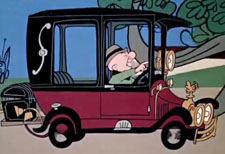 Meanwhile, a large plane in the air calls the control tower, indicating an emergency, as their landing wheels are stuck and won’t come out, necessitating a belly landing. The tower tells them to come in on the same runway upon which Magoo’s car rests. Inside the cab, Magoo moans and nearly weeps over his steering wheel, having been at it all night without one person stopping for him, making him entirely lose faith in his fellow man. The pilot of the plane meanwhile tells his co-pilot to watch closely, as he has had much experience in emergency landings, and will demonstrate how to make the plane “kiss the runway.” Suddenly, Magoo feels a jolt, and believes that a good Samaritan has finally arrived to give him a little push. The plane has belly-landed atop the hardtop shell of Magoo’s car, and is propelling it down the runway. Magoo leaves the brakes open, and attempts to start up the car engine. “She’s starting to fire. Just a little bit farther.” The co-pilot asks when they’re going to stop, as they’ve now passed the airport. They proceed down Washington Boulevard, and the co-pilot notes they just passed his house – and also ran a red light. The car engine kicks in – just as another jolt leaves the plane stuck by its wings between two buildings on opposite sides of the street, “Thanks again, neighbor”, shouts Magoo, as he put puts down the street, stating, “My faith in mankind has been restored.”
Meanwhile, a large plane in the air calls the control tower, indicating an emergency, as their landing wheels are stuck and won’t come out, necessitating a belly landing. The tower tells them to come in on the same runway upon which Magoo’s car rests. Inside the cab, Magoo moans and nearly weeps over his steering wheel, having been at it all night without one person stopping for him, making him entirely lose faith in his fellow man. The pilot of the plane meanwhile tells his co-pilot to watch closely, as he has had much experience in emergency landings, and will demonstrate how to make the plane “kiss the runway.” Suddenly, Magoo feels a jolt, and believes that a good Samaritan has finally arrived to give him a little push. The plane has belly-landed atop the hardtop shell of Magoo’s car, and is propelling it down the runway. Magoo leaves the brakes open, and attempts to start up the car engine. “She’s starting to fire. Just a little bit farther.” The co-pilot asks when they’re going to stop, as they’ve now passed the airport. They proceed down Washington Boulevard, and the co-pilot notes they just passed his house – and also ran a red light. The car engine kicks in – just as another jolt leaves the plane stuck by its wings between two buildings on opposite sides of the street, “Thanks again, neighbor”, shouts Magoo, as he put puts down the street, stating, “My faith in mankind has been restored.”
Steer into the supersonic sixties, next time.




 Charles Gardner is an animation enthusiast who toils by day as a member of LA Law – but by nights and weekends indulges in classic jazz and ragtime as a performer; and studies classic Hollywood cartoons… maybe a little too much.
Charles Gardner is an animation enthusiast who toils by day as a member of LA Law – but by nights and weekends indulges in classic jazz and ragtime as a performer; and studies classic Hollywood cartoons… maybe a little too much.


































































































































































It’s unusual to have four Woody Woodpecker cartoons in a single post, but I enjoyed all of them, even “Bedtime Bedlam” with its illogical denouement. The Sitting Pretty/Sitting Bull connection goes back to the 1952 cartoon “Scalp Treatment”, in which Woody and Buzz Buzzard vie for the affections of the beautiful Indian princess Sitting Pretty. The “Pease porridge hot” gag was later used in the Flintstones episode “The Long, Long, Long Weekend”, with Bamm-Bamm shoving Fred offscreen and into a tree while playing pattycake. (This is the episode where the Great Gazoo sends the Flintstones and Rubbles forward in time to the 21st century, one of the highlights of the show’s final season.)
There’s a Yiddish obscenity in “Round Trip to Mars”, when Professor Dingledong says “I get you now, you little schmeggle!” “Schmeggle” is the diminutive form of “schmuck”, which is probably the most offensive of all the many Yiddish words for penis. I don’t see any Jewish names in the credits to this cartoon, so I wonder if maybe story man Dalton Sandifer or someone else on the Lantz staff might have heard the word somewhere without knowing what it meant, and just thought it had a funny ring to it. It does, at that, but then so do most Yiddish words.
It might just be a coincidence that a General “Clayburger” is mentioned in “Magoo’s Private War”, but General Franz Kleberger (pronounced much the same) was one of the senior officers on Reichsmarschall Goering’s general staff during World War II.
It is definitely a coincidence, and quite a remarkable one, that in “Magoo’s Three Point Landing”, a pilot named Sully boasts of being “famous for my emergency landings”. There was, of course, a pilot named Sully in real life, who famously made an emergency landing in the Hudson River in 2009 and whose heroic exploits were recounted in a feature film starring Tom Hanks several years ago. Sully’s co-pilot in the cartoon seems to be a graduate of the Mister Jinks School of Elocution — like, uh, y’know.
Well, another grand group of cartoons here as usual. Every time I catch “THE UNBEARABLE SALESMAN”, I’m reminded that I once had a silent 8-mm print of this cartoon in black and white for the short time I had a projector, and I ran the print quite often. I’m so glad that it is now available with sound and full color on the second of two WOODY WOODPECKER AND FRIENDS collections; thanks, Jerry Beck and whoever else was responsible. We need more such volumes!
In Australia, the word “jelly” refers to a moulded, fruit-flavoured gelatin dessert like Jell-O, and not something that you spread on bread (which is why Australians are so disgusted by the idea of a peanut butter and jelly sandwich). By far the most popular brand is Aeroplane Jelly, which has been around for close to a century. The Aeroplane Jelly song (“I like Aeroplane Jelly! Aeroplane Jelly for me!”), dating back to the days of radio, is still used in advertising today. Most Australians, especially older ones, can sing the Aeroplane Jelly jingle, which is more than you can say for the national anthem.
In the mid-1950s, animator Eric Porter (known as “Australia’s Walt Disney” in the nation’s press, and later the director of the first Australian-made animated feature “Marco Polo Jr.”) made a series of cartoons for theatrical release, between two and three minutes long, as advertisements for Aeroplane Jelly. These featured an anthropomorphic airplane named Bertie. At first he had a propeller on his nosecone, but later lost it and became “Bertie the Jet”. In one cartoon, Bertie encounters some flying saucers in a thunderstorm; another, which would have coincided with the 1956 Melbourne Olympics, concerns a cross-country air race pitting Bertie against planes from France, America, England and Italy, whizzing past Australian landmarks like the Sydney Harbour Bridge and the Three Sisters (a rock formation in the Blue Mountains). In the end, Bertie attributes his energy and stamina to a diet rich in Aeroplane Jelly. Funny, you’d think all that sugar would gum up his engines.
I don’t know whether advertising falls within the purview of this series, but these cartoons are fairly entertaining and were shown in cinemas for many years. The animation is on a par with what the major American studios were turning out at this time. The Aeroplane Jelly cartoons, like much of Eric Porter’s work, can be seen on YouTube today and are definitely worth a look.
By 1956 the move from Famous Studios to Terrytoons was upwardly mobile. It is rather nice to see the “classic” Harveytoons credits (with actual credits) after the truncated 1990s version.
With all due respect, I have to diagree with the assertion that the animation in the short “Good Will to Men” is “passable by 1950’s standards” In terms of content, it’s kinda boring, yet it’s only fair to give credit where it’s due for its rather high production values